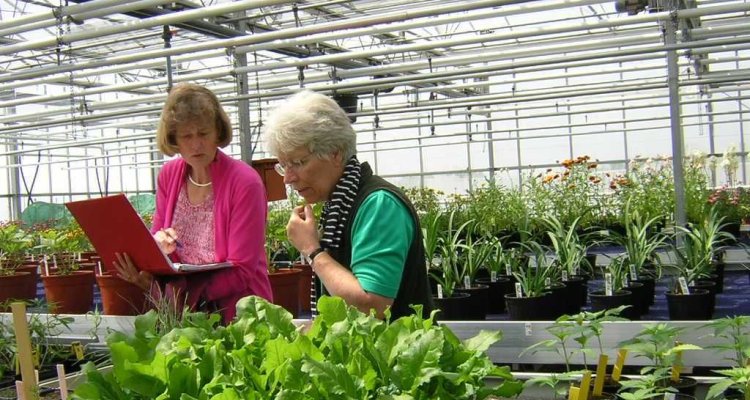
Regeneration of lettuce
Seed dormancy
Seed dormancy is quite common for wild relatives of cultivated lettuce (Lactuca sativa). Wild crop relatives are sown on moist filter paper in Petri dishes that are placed at 4°C for a few days. The germination of wild species can be further enhanced by removal of the seed coat and fruit wall or cutting off a small part of the top of the seed (achene). For species with seeds that are too small to remove the fruit wall and seed coat, such as for L. biennis, L. dentata and L. tatarica, the germination period is prolonged to at least 3 weeks. In addition, repeated cold treatments may increase germination.
Vernalization
Many of the wild crop relatives are winter annuals or biennials that require a period of low temperature to induce flowering. Therefore, seedlings of wild species are placed at 1°C for 6 weeks.
Sowing
Seeds of cultivated material are sown in seed trays in the first week of April. Seeds of wild relatives are placed on moist filter paper in Petri dishes in the second half of February. After dormancy-breaking treatment, the Petri dishes are stored at room temperature until appearance of the radicle, after which the seedlings are vernalized. After full development of the cotyledons, seedlings are transplanted to peat pots and grown in a greenhouse at a day/night temperature regime of 18/10°C.
Planting
Young plants are transplanted to large pots at the end of April. Greenhouses are ventilated in order to prevent rotting due to high humidity. L. homblei and L. indica need short day conditions to induce flowering and therefore are grown under half day/half night conditions until flower appearance. A few wild species such as L. perennis, L. tatarica, L. sibirica and some L. viminea accessions are cross-pollinating, and therefore regenerated in isolation using flies as vector. This also applies to species for which the reproductive behaviour is not fully understood, such as L. orientalis, L. undulata and Chondrilla juncea. To force plants to bolt and to prevent rotting, all heading lettuces are treated with Gibberellic acid (20 ppm) before the start of heart formation. Plants are supported by wooden stakes to prevent lodging. The oldest leaves of cultivated material are continuously removed to prevent rotting. Homogeneous accessions are regenerated with 8 plants, while 16 plants are used for heterogeneous samples, such as landraces and wild species. In case of extremely heterogeneous samples, 24 plants are used.
Pest and disease control
Accessions are preventively treated against infection by aphids (Myzus persicae & Nasonovia ribisnigri), Pythium spp. and Botrytis cinerea. Non-preventive measures include treatments against white fly (Trialeurodes vaporariorum), spider mites and powdery mildew (Erysiphe cichoracearum). Two weeks after planting in the greenhouse, leaf samples are collected and tested for the presence of the Lactuca Mosaic Virus using ELISA. Only healthy plants are maintained for seed production.
Harvesting
Individual plants are manually harvested when the majority of seeds have ripened. Uniform material such as cultivars usually require only a single harvest, while some wild species with prolonged flowering periods, such as L. perennis and L. tenerrima are harvested several times to avoid selection for flowering time. Because of the ease of seed shattering, the inflorescences of wild species are wrapped in perforated polythene bags to prevent severe loss of seeds and to reduce the probability of contamination. Harvested inflorescences are collected in paper bags and transferred to the drying and cleaning facility. Harvesting time may range from the beginning of August to the end of October. In case of insufficient flowering or insufficient seed yield, plants may be overwintered in a heated greenhouse at approximately 10°C. This may apply to species such as L. viminea and L. georgica that, in spite of the vernalization treatment, may still behave as a biennial.